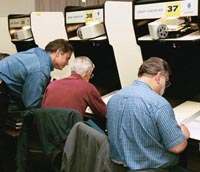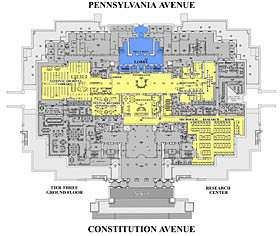
NARA's New Research Center Features Ease, Speed, Efficiency
Fall 2003, Vol. 35, No. 3
By Kenneth W. Heger
You'll soon find that your research visit to the National Archives in downtown Washington, D.C., will be easier, speedier, and more efficient as a result of the renovation of the National Archives Building.
A number of research services formerly housed on upper floors of the sixty-eight-year-old building—along with some new services—are included in a new ground-floor National Archives Building Research Center. Opening this fall, the Center will include more records, finding aids, and staff assistance as well as more amenities for researchers and visitors.
The aim of the new Center is to improve "ready access to essential evidence," as reflected in the mission of the National Archives and Records Administration (NARA). Thousands of researchers come to the National Archives Building annually to search records of their own family as well as those that document their rights, the actions of government officials, and the national experience.
Michael Kurtz, assistant archivist for records services–Washington, D.C., said the Center would provide "the opportunity for an integrated approach to customer service and research." He added:
The newly renovated Research Center will provide expanded and improved space for the many researchers who come to the building. It will house improved microfilm reading room space, dedicated space for pension and military service records research, an enhanced and improved library service, as well as areas set aside for researcher consultation and sales of NARA publications.
Upon entering the new Center, just inside the Pennsylvania Avenue entrance, visitors will find themselves in a large wood-paneled lobby with easy access to its various components—all of which will allow researchers to do much of their work on a single level instead of shuffling between floors of the building.
First Stop for Genealogists
The Genealogy Consultation and Microfilm Research rooms will be the most familiar spaces to many of NARA's researchers and are the major components of the Research Center. In these rooms, archivists and archives specialists will assist you with genealogical research, issue research cards, and make microfilmed and microfiched indexes and records available.
You'll be able to get assistance in developing research strategies and locating relevant microfilm publications as soon as you enter the Genealogy Consultation Room—but before you enter the Microfilm Research Room. In this way, researchers can concentrate on their work without being disturbed by research consultations.
Also in the Genealogy Consultation Room, you'll have access to computers to consult online finding aids. In addition, you'll have access to an array of printed "search paths." These include staff-prepared search paths on topics relating to military service, the African American experience, enumeration of Native Americans, the careers of federal employees, and other topics.
These search paths can provide you with references to the most worthwhile records with which to begin your research, allowing you to start examining records sooner and without the need for lengthy consultations and note taking. Staff and volunteers will assist you in locating and understanding pertinent search paths.
In this room, you can also obtain a research identification card. Rules for issuing research cards will remain the same. Prospective researchers will still need to have a specific research topic, be at least fourteen years old, have a valid official identification that includes a photograph, and proof of current address.
Microfilm Research Room
The Microfilm Research Room will undergo some minor changes and will house many more microfilm publications.
Although there will be fewer microfilm readers than have previously been available to researchers, the new microfilm reader stations will be more comfortable, afford more privacy, and offer more flat space on which to take notes. All microfilm readers will be equipped with electrical power to facilitate laptop computer use.
In addition, there will be almost twice as many microfilm printers in the new Microfilm Research Room, a move aimed at eliminating a long-time bottleneck for researchers.
Thousands of rolls of new microfilm publications will be added over the next several years. The ongoing project to microfilm the records of the Freedmens' Bureau will yield several hundred rolls of microfilm documenting the African American experience. There will also be new microform publications documenting service in the armed forces of the United States.
NARA will continue to microfilm the Compiled Military Service Records of the United States Colored Troops and will make available almost 54,000 microfiche of navy pension files. The microfilming of Immigration and Naturalization Service records will result in hundreds of new rolls, many of them records of Mexican border crossings.
To make it easier to research the careers of early American foreign service employees and other civil servants, the new Center will have a complete set of the microfilmed application and recommendation files of the Department of State (1797–1877). Currently those files are available only at the National Archives at College Park.
Military Service Research Room
One of the new features of the Center is the Military Service Research Room. In that room, you may examine Compiled Military Service Records for volunteer soldiers, pensions, and bounty-land warrant files. (This room will have military personnel records up to just before World War I; military personnel records from World War I to the present are at the National Personnel Records Center in St. Louis, Missouri.)
Relocating this function from the second floor's Central Research Room will save researchers much time and frustration. The Military Service Research Room will have twenty-four work stations and two copy machines. You must show the staff member on duty any files you wish to copy and show the copies to the guard as you leave the room.
You will still need to have a researcher identification card to examine records in the Military Service Research Room. Like the Central Research Room, this room will have a uniformed guard at the front desk to scan researcher cards to allow entrance into the room and provide additional security for the documents.
The Military Service Research Room will be a "clean research room," where you may not take coats, jackets, purses, pens, books, or other items. You will be provided note cards, paper, and pencils. More information about regulations is available at www.archives.gov under "Research Room/Getting Started."
Textual Finding Aids Room
The Finding Aids Room is moving from Room 410 to the new Research Center, near the Genealogy Consultation Room. Archivists and archives specialists will be on duty to help you develop strategies and navigate NARA's finding aids, and more computers will be available to access online finding aids. Although other parts of the Research Center will have extended hours, this room will only be open Monday through Friday between 8:45 a.m. and 5 p.m.
The Archival Library Information Center
The Archival Library Information Center (ALIC) will also be located on the ground floor after the renovation, and its role in the research process will increase.
The number of volumes available to researchers in ALIC will expand markedly. A large part of ALIC's holdings have been in alcoves in the stacks, but now virtually all of ALIC's holdings will be in open shelving, making them readily available to researchers. This greater accessibility will be especially beneficial to those who wish to consult the Official Register of the United States, the American State Papers, and other government publications.
Family historians will find in ALIC all of the bound and CD-ROM indexes to the federal census, and ALIC's professional librarians can assist you in locating and using these indexes. The library will expand its hours of operation to ensure that there is always staff on duty when the building is open.
Cashier and Publications Sales Area
The Research Center will house the Cashier's Office and a small publication sales area. There, you can buy debit cards, exchange large bills for small ones, pay for copy orders, and purchase National Archives finding aids. This operation will be available Monday through Friday between 9 a.m. and 4:30 p.m.
New Amenities
One of the first things researchers will note is the ease with which they will have access to the basic necessities associated with research.
With twenty computers, the new research complex will have five times the number of terminals currently available to researchers. Positioned in the new Genealogy Consultation Room, Finding Aids Room, and ALIC, these computers will provide access to NARA databases, such as the Archival Research Catalog, ALIC's catalog, and Access to Archival Databases. They will also allow you to use finding aids to NARA records available on CD-ROM and provide access to the Internet.
Researchers will find 218 new lockers to replace the 100 currently located in the hallways on the second and fourth floors. These lockers will serve a variety of researcher needs, as they will be of various sizes. A change machine will be located in the locker room, and there will be new restrooms conveniently located within the Research Center.
The Central Research Room
The Central Research Room will remain in its current location on the National Archives Building's second floor in Room 203. Researchers will continue to examine textual records in that room, except for military service records, pension files, and bounty-land warrants. Records to be reviewed in the Central Research Room will be ordered on the ground floor in the Finding Aids Room. You will still need a valid researcher identification card in order to enter the room, and the "clean research room" policy remains in place.

